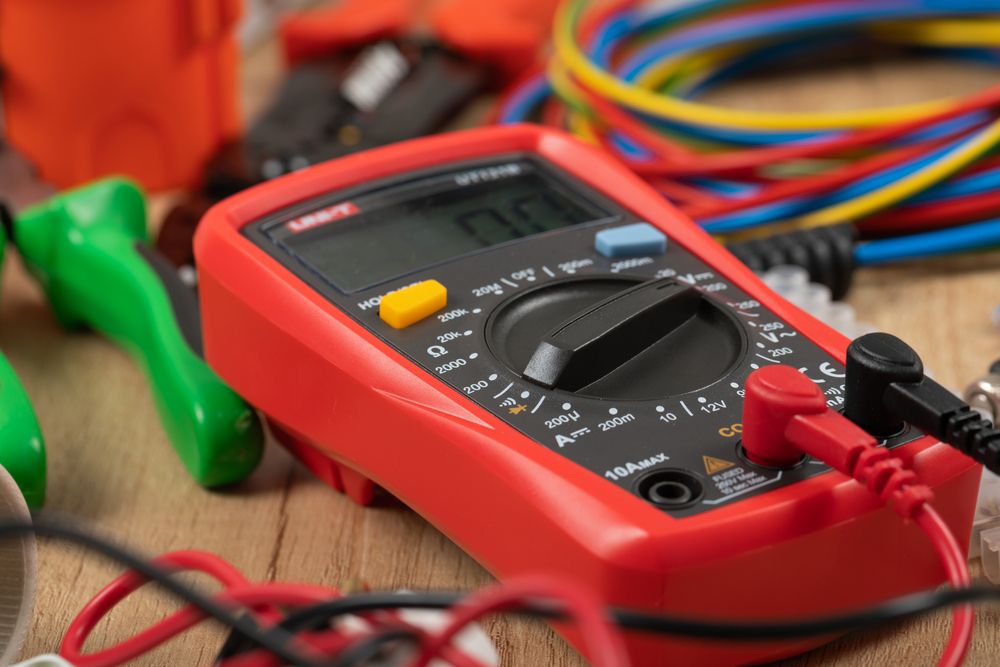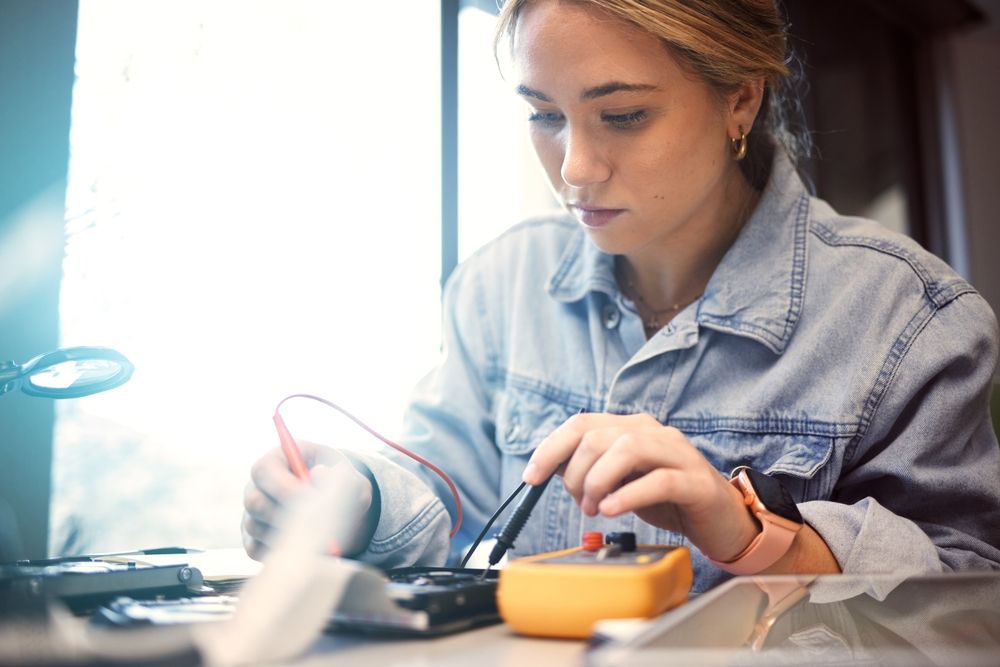What Is a Multimeter?

A multimeter is one of the most necessary tools in electronics, whether you're troubleshooting a circuit, checking a power source, or testing a component. It's a device that combines several measurement functions, making it a must-have for engineers, technicians, and other professionals.
But with so many features and settings, understanding how to use one effectively can feel overwhelming. This multimeter guide breaks down what a multimeter is, what it measures, and why it's an indispensable tool for diagnosing and repairing electronic systems.
One Compact, Essential Tool
Accuracy is everything in electronics. When circuits fail, power supplies fluctuate, or components need verification, engineers and technicians turn to a multimeter. This compact tool simplifies several measurements, so it's a staple for troubleshooting and maintenance. Its value stretches across industries — whether in industrial automation or telecommunications, where even small miscalculations can lead to major disruptions. Knowing how to use a multimeter effectively helps engineers pinpoint issues, confirm performance, and keep critical systems running without costly setbacks.
The Basics: What Is a Multimeter Used For?
A multimeter is a handheld or benchtop testing device that measures key electrical properties—voltage, current, and resistance. Engineers and technicians use it to troubleshoot circuits, verify electrical components, and ensure systems function within specified parameters.
At its core, a multimeter serves three primary functions:
- Voltage Measurement: Checks the electrical potential difference between two points in a circuit, which is crucial for verifying power supplies and signal integrity.
- Current Measurement: Measures the flow of electric charge, helping to detect overloads or faulty components.
- Resistance Measurement: Determines how much a material or component opposes current flow, helpful in diagnosing damaged resistors, connections, and wiring.

Multimeters are available in two main types: analog and digital. Analog models display readings using a needle gauge and are preferred when detecting fluctuations is necessary. Digital multimeters (DMMs), on the other hand, provide more precise numerical readings on an LCD screen, making them the industry standard for accuracy and ease of use.
Key Multimeter Functions and Measurements
Let's look more closely at multimeter functions. Understanding how to use these functions properly helps diagnose issues, verify performance, and ensure circuits operate as intended.
Voltage Measurement: AC and DC Testing
Voltage is the force that drives electrical current through a circuit. A multimeter can measure direct current (DC) voltage, used in batteries and electronic circuits, and alternating current (AC) voltage, found in power supplies and household outlets. Engineers set the multimeter to the appropriate AC or DC mode to test voltage, connect the probes to the circuit, and get an instant reading. This helps identify power fluctuations, faulty power sources, or incorrect voltage levels in a system.
Current Measurement: Ensuring Safe Flow
Measuring electrical current reveals how much charge is flowing through a circuit. Unlike voltage testing, where the probes are placed across a component, current measurement requires placing the multimeter in series with the circuit. Since excessive current can damage components or cause overheating, engineers use this function to check for overloads or unexpected power draws. Some digital multimeters also include a clamp feature, allowing for non-contact current measurement — ideal for high-power applications.
Resistance Measurement: Diagnosing Faults
Resistance testing determines how much a material or component opposes the current flow. This function is crucial for checking the integrity of resistors, verifying wiring, and identifying broken connections. A multimeter measures resistance by sending a small test current through a component and analyzing how much is blocked. Engineers also use this mode for continuity testing, which confirms whether a connection is complete or interrupted — essential for pinpointing faults in complex circuits.
How to Use a Multimeter: A Quick Guide
Knowing a multimeter's purpose is one thing. Understanding how to use it is another. Using a multimeter correctly ensures accurate readings and prevents damage to the device and the circuit under test. While different models have varying features, the basic setup remains the same.
Setting Up and Taking Measurements
To use a multimeter, you need to:
- Select the Correct Setting – Turn the dial to the appropriate function: voltage (AC or DC), current, or resistance.
- Plug in the Leads – Insert the black lead into the COM (common) port and the red lead into the correct port for the measurement type. Most multimeters have a dedicated port for high-current testing.
- Connect to the Circuit
- Place the probes in parallel across the component or power source for voltage.
- For current, break the circuit and connect the multimeter in series.
- For resistance or continuity, touch both probes to the component being tested.
- Read the display. The multimeter will provide a real-time numerical value for the selected measurement.
- Power Off and Store Properly – Always turn off the multimeter when finished to preserve battery life.
Safety Considerations
As you use a multimeter, you should make sure to:
- Check Voltage Ratings – Ensure the multimeter’s voltage rating matches or exceeds the tested circuit to avoid overload.
- Use the Right Ports – Plugging leads into the wrong ports, especially for current measurements, can damage the multimeter or create a short circuit.
- Avoid Measuring Live Circuits in Resistance Mode – Resistance and continuity tests should only be performed on de-energized circuits to prevent inaccurate readings or device damage.
- Inspect Leads and Probes – Damaged wires or worn-out insulation can create a safety hazard.
Common Mistakes to Avoid
To get the most out of your multimeter, you want to avoid:
- Using the Wrong Setting – Measuring AC voltage with the multimeter set to DC (or vice versa) will result in incorrect readings.
- Testing Current Incorrectly – Never connect the probes directly across a power source in current mode — this creates a short circuit, which could damage the multimeter and the circuit.
- Forgetting to Reset the Dial – Leaving the multimeter in a high-current setting when switching to another measurement can lead to errors or blown fuses.
- Ignoring Battery Levels – Low battery power can cause inaccurate readings, so checking the battery periodically is a good practice.
Mastering these basics ensures reliable results and helps engineers quickly diagnose electrical issues without risking equipment failure or personal safety.

Choosing the Right Multimeter for the Job
Not all multimeters are built the same. Engineers and technicians need a device that meets the demands of their specific applications — whether it's troubleshooting industrial equipment, testing precision electronics, or working with high-voltage systems. Selecting the right multimeter comes down to understanding key features and performance factors.
What to Look for in a Multimeter
To identify the best multimeter for your application, you should consider:
- Measurement Accuracy – Higher-end digital multimeters (DMMs) offer greater resolution and precision, which is critical for working with sensitive electronics.
- Voltage and Current Range – Ensure the multimeter can handle your application's maximum voltage and current levels, especially for industrial or power electronics.
- Auto-Ranging vs. Manual-Ranging – Auto-ranging multimeters simplify measurements by selecting the correct range automatically, while manual-ranging models provide more control for experienced users.
- Safety Ratings – Look for CAT ratings (Category I-IV) that indicate protection levels for different environments, from low-energy circuits to high-power installations.
Matching Features to Engineering Applications
The multimeter you select also will need to align with your specific application:
- General Electrical Work – A basic DMM with voltage, current, and resistance functions is sufficient for routine circuit testing.
- Industrial and Power Electronics – Look for high-voltage capabilities, true RMS (TRMS) readings for AC accuracy, and a high CAT safety rating.
- Precision Electronics and R&D – Multimeters with high resolution, low error margins, and data-logging capabilities are ideal for lab environments.
- Field Service and Maintenance – A rugged, portable multimeter with a backlit display, clamp functionality, and wireless connectivity enhances usability in the field.
Choosing the right multimeter ensures efficiency, accuracy, and safety in testing and troubleshooting. You can use Octopart's user-friendly interface to locate numerous multimeters for sale.
Trust Octopart for Your Multimeter Needs
A multimeter is necessary for engineers and technicians to diagnose, test, and maintain electrical systems. Whether measuring voltage, checking current flow, or troubleshooting circuit issues, a reliable multimeter provides the precision and insights needed to keep systems running efficiently. Choosing the right one depends on the job at hand, from basic circuit checks to high-voltage industrial applications. Octopart provides up-to-date pricing and stocking information and lets you compare models to ensure you find the best multimeter for your application.
Frequently Asked Questions About Multimeters
What are some advanced uses of a multimeter in professional settings?
While multimeters are primarily used to measure voltage, current, and resistance, advanced models may include frequency measurement, capacitance testing, temperature probes, and non-contact voltage detection, useful for specialized applications.
How should a multimeter be maintained to ensure accuracy and longevity?
Proper maintenance keeps a multimeter reliable and extends its lifespan. Here are some key practices:
- Store It Properly – Keep the multimeter in a dry, dust-free case when not in use to protect it from environmental damage.
- Check and Replace Batteries – Low battery levels can lead to inaccurate readings, so replace them as needed.
- Inspect Test Leads Regularly – Damaged or frayed leads can cause faulty readings and pose a safety hazard. Replace them if they show wear.
- Calibrate Periodically – For precise measurements, especially in professional settings, calibrate the multimeter as recommended by the manufacturer or industry standards.
- Avoid Exceeding Ratings – Never test voltage or current levels beyond the multimeter’s specified limits to prevent damage to internal components.
What are the essential features of a good multimeter?
The right multimeter depends on the application, but some key features make a significant difference:
- True RMS (TRMS) Capability – Ensures accurate AC voltage and current readings, especially for non-sinusoidal waveforms.
- High Voltage and Current Capacity – Essential for industrial and power electronics applications.
- CAT Safety Ratings – Higher CAT ratings (I-IV) indicate better protection against electrical surges in different environments.
- Durability and Build Quality – A rugged, well-built multimeter with a protective casing lasts longer, especially for fieldwork.

